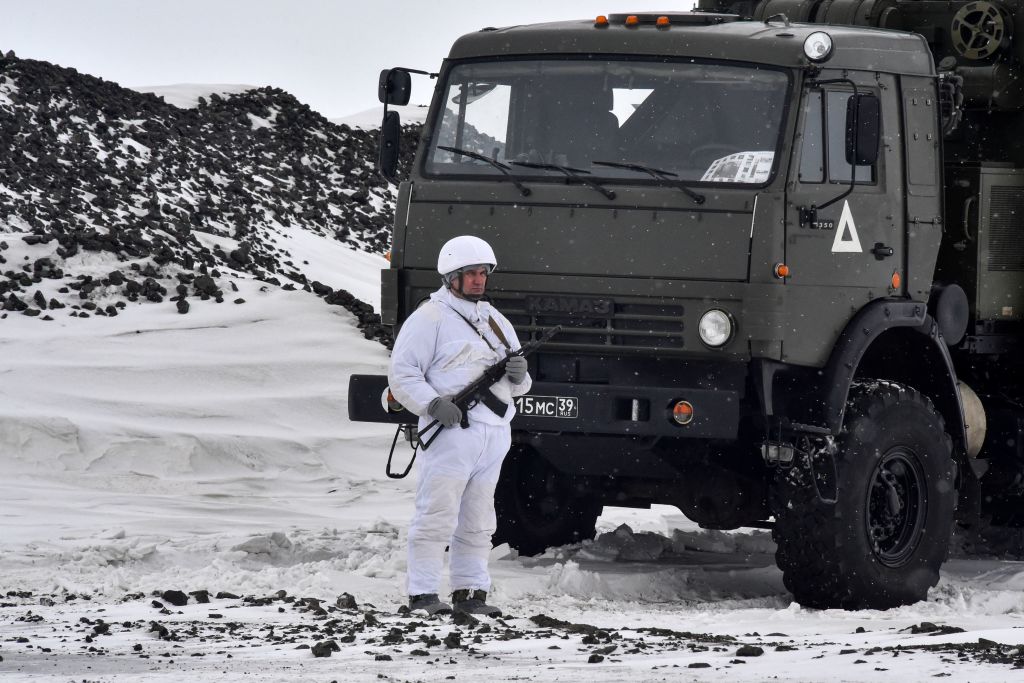A Russian serviceman stands guard by a military truck on the island of Alexandra Land, which is part of the Franz Josef Land archipelago in the Arctic. Russia has sought to restore its Arctic primacy by repairing and upgrading military facilities. AFP/GETTY IMAGES
DR. CHARLES E. MORRISON
In my elementary school days, textbooks portrayed the Arctic as an icy region inhabited by friendly Eskimos living in igloos amid polar bears, walruses and seals. In more recent decades, a new narrative appeared of the region, with melting sea ice providing access to new trade routes and resources. This has led to yet another narrative of large power competition and potential conflict over those resources.
Like most situations, all these images have some validity, but let’s look specifically at the last — the security challenge. It is obvious that geopolitical tensions have increased in recent years. But on the other hand, compared with other world regions — the Indo-Pacific, Eastern Europe, the Middle East, or the developing world — the Arctic is characterized by relatively low conflict. It has fully agreed land borders, stable political units and no kinetic conflicts.
The U.S. Department of Defense’s (DOD) Arctic Strategy 2024, which updated the 2019 strategy, featured a “monitor-and-respond” approach. Despite the new terminology, much of the 2019 and 2024 reports were remarkably similar including the broad policy goals (peaceful, stable), the threats (China, Russia), and the emphases on cooperation across services, with allies, and with other stakeholders including Indigenous peoples.
A key point in both reports is that the Arctic is not a stand-alone region, but integrally connected with the rest of the world, especially Europe and the Indo-Pacific. Therefore, security policies and funding choices must take into account larger national security priorities. However, popular media often only focus on a single location and point to the contrasts with an earlier period, not the rest of the world.
Exceptionalism
If today’s Arctic is compared with the Cold War Arctic, we seem back to the future: two Arctics, one NATO-dominated, the other the Russian Arctic. When compared with the 1990s, when the U.S. was a single superpower and Russia was weak, the circumpolar Arctic Council was created, and all kinds of scientific, Indigenous and other cooperation blossomed. This led to the hope of Arctic “exceptionalism,” that the region might escape geopolitics. But it was not the Arctic that was exceptional, just the time period.
Resurgent Russia
By 2007-08, geopolitics had returned, and it was mostly associated with Russia’s resurgence. As Russia stabilized, it sought to restore its Arctic primacy, repairing abandoned or degraded military facilities and increasing its military capabilities, especially around Murmansk, the ice-free port where much of its naval and nuclear forces are concentrated.
The offensive capability inherent in this Russian buildup alarmed NATO members, who saw their strategic advantage eroded, and they took steps to respond. But a new factor had appeared – China.
The Chinese Role
Norwegian lawyer Hedvig Moe has likened the revived Russian threat to a tornado forcing an immediate response; China is more of a distant, slowly emerging challenge. Having global interests and ambitions, China wants to be an acknowledged Arctic player. But as a non-Arctic nation, its access is limited. Most of its involvements so far involve research, shows of presence and natural resources, but its only major financial investment lies in Russia’s oil-and-gas rich Yamal Peninsula where it benefited from the withdrawal of western firms following the 2014 Crimea-related sanctions.
The prolonged Ukraine war has deepened Russia’s dependence on China but dampened Chinese interest in Russia. Because of sanctions, China’s proposed “Polar Silk Road” became not a highway to Europe, but only to Russia and its Italy-sized economy. Fear of secondary sanctions deterred major new Chinese investments, although trade has increased.
Beijing continues to accord Moscow symbolic support, including participation in now regular military exercises in the North Pacific, including near Alaska. So far these are not considered a threat, but their purpose may be mainly to rattle the U.S. China is expanding its nuclear forces, and a future world of three nuclear peer powers will be an unprecedented challenge for the U.S., and especially dangerous if the other two work closely together.
What Should Be Done?
The Arctic Strategy 2024 provides a sensible road map for the future, both in general approach and in such specifics as strengthening domain awareness, deepening allied cooperation, upgrading infrastructure and strengthening and broadening exercises. The goal, both previous strategies emphasize, is to keep the peace.
In 2021, the East-West Center and Korea Maritime Institute sponsored the North Pacific Arctic Conference (NPAC). They asked three prominent specialists – Oran R. Young from the U.S., Jian Yang of China and Andrei Zagorski of Russia – to develop “common ground.” In addition to specific suggestions, they came up with a new narrative label — “peaceful competition.” No doubt, the large powers will compete in the region, even as some areas of cooperation remain and hopefully others will eventually be restored. The challenge is to ensure even if intensified, the competition remains peaceful.
Dr. Charles E. Morrison is a research fellow and former president of the East-West Center.
The opinions expressed do not necessarily represent the policies or points of view of USNORTHCOM or the United States Government.

